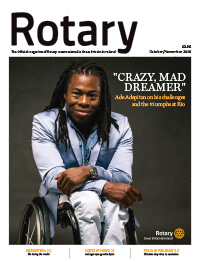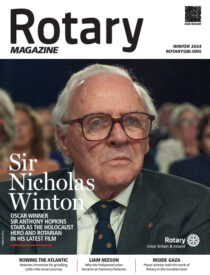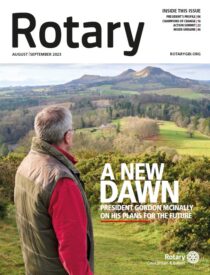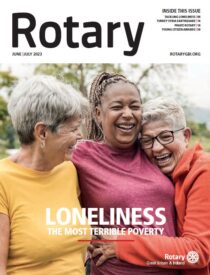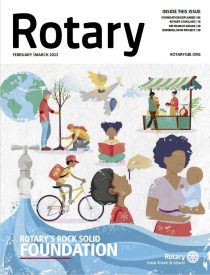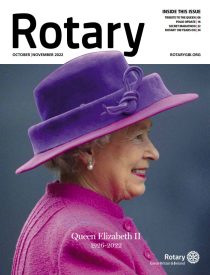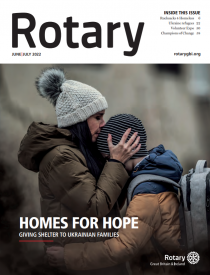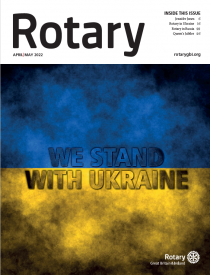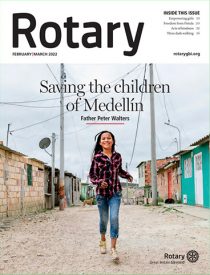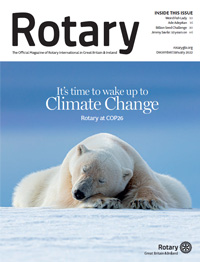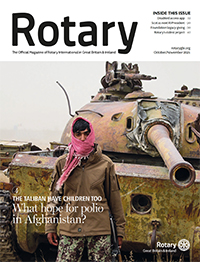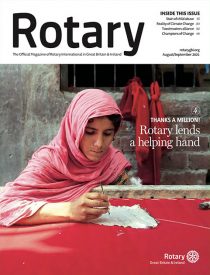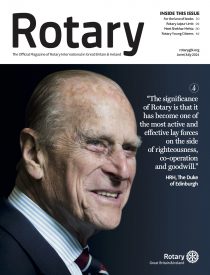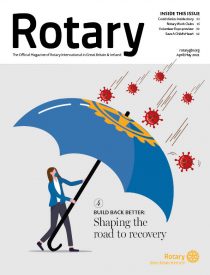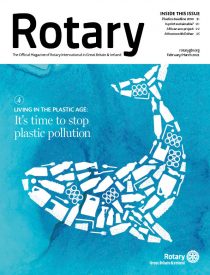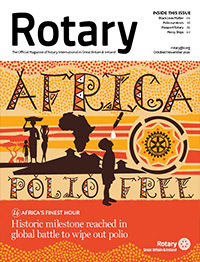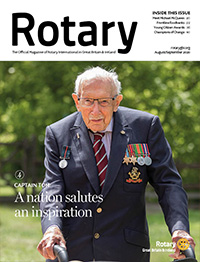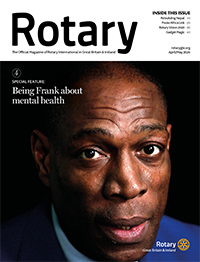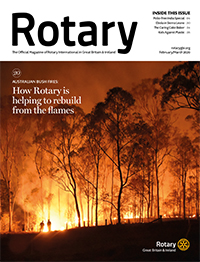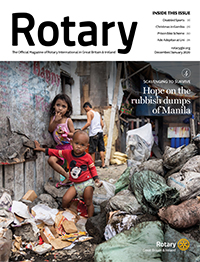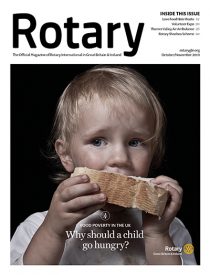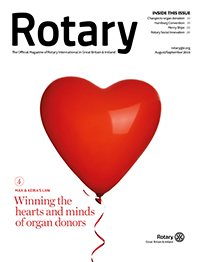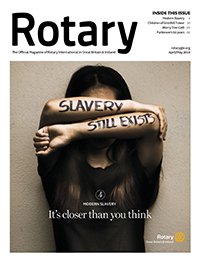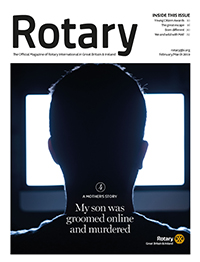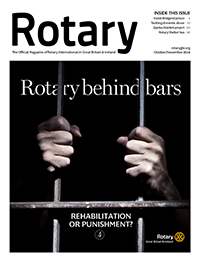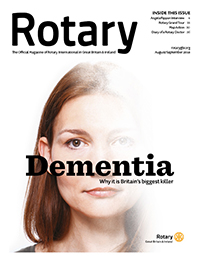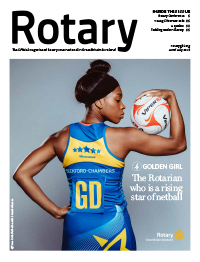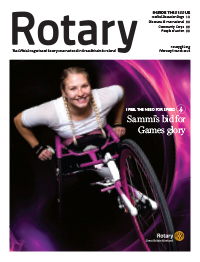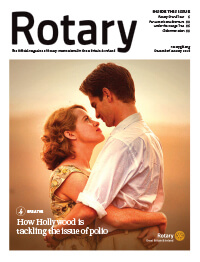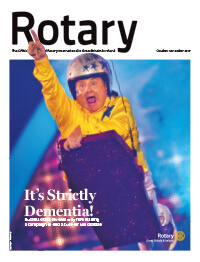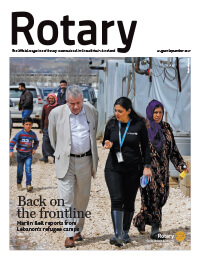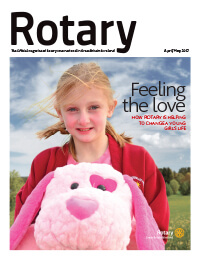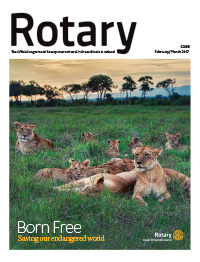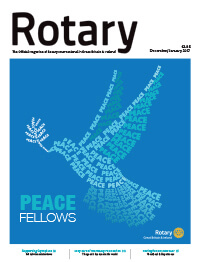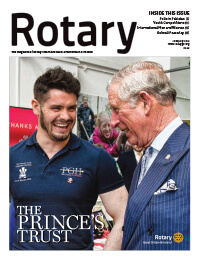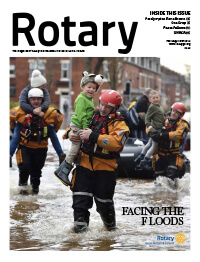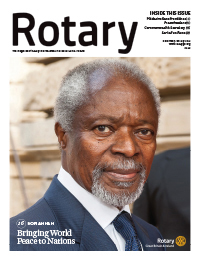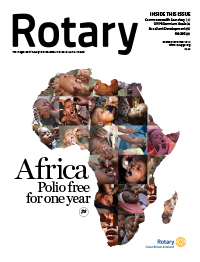It’s now over two years since I interviewed the CEO (Chief Executive Officer) of ShelterBox. Since then we have seen a number of disasters happening in the world, some natural and others man made.
Each time ShelterBox has been there with Rotary helping in any possible way to bring normality and shelter to families who are affected.
To cement that working relationship this year Rotary International and ShelterBox renewed their partnership for another three years so it was time I revisited this humanitarian organisation to get an update.
During the year ShelterBox has made some changes and key is a new CEO, Chris Warham. Chris and I met up to discuss the developments in the organisation and how they affected Rotary. We started by Chris telling me about his journey to become CEO of this much respected and renowned charity.
Chris told me, “It was Christmas 2009. I was just about to celebrate a birthday by running a marathon and one weekend I was visiting a garden centre with my son. Outside were Rotarians from the Rotary Club of Bramhall and Woodford with a green ShelterBox.”
“We looked inside and one of the Rotarians came over and told us all about ShelterBox. As a result, I ran the marathon for ShelterBox and not only raised a lot of money but was also inspired to research them further, which led to me applying and training as an SRT (ShelterBox Response Team) member.”
I ventured to say that the training is rigorous and Chris agreed, “It is rigorous, I completed the training and then went on to a number of deployments purely as a volunteer. The two significant ones were in the Philippines after hurricane Haiyan and in Congo-Brazzaville after an arms dump explosion.”
“It was exciting to do that and it has given me a good insight into what it is all about. When you look into the eyes of a mother in a displaced persons’ camp it brings all this stuff into perspective. As a result of all that I got further involved and using my professional background I got involved in some PR issues that were bouncing around and as the board renewed itself they did a skills audit looking for peak skill sets.”
“The board looked at what skills it required in order to drive a strategic plan and now we have a really strong board.”
The empty chair in the room is for the beneficiary who does not yet know they will have to flee their home and every discussion we have, every decision we make and every penny we spend has to be focused on meeting the needs of the person in the empty chair.”
Chris did spend the time with me going through the skills and experience of the board members and it is impressive. Each board member has a skill set in their specialisation and especially one with experience in humanitarian aid.
We went on to determine how Chris made it to CEO, “I spent three years as a trustee and chaired the risk and audit committee and when Alison Wallace (the former CEO) left on February 29 I tookon the CEO role as interim whilst the board went through the due process of seeking a replacement. I was appointed as permanent CEO by the board on June 15. I suppose my credentials are that I have fundraised, deployed, I have been involved with the governance and I’ve had experience of running organisations and as I say to all the volunteers and workers – I am passionate about the mission.”
This type of skill and experience by any standards for any organisation is a tremendous asset but add to that the passion and motivation that has obviously gripped Chris from his time in disaster zones and it is apparent ShelterBox has a highly driven CEO at the helm.
I spent a couple of hours with him and his ideas and strategies are honed by his deployment experiences and as we moved on to talk further this was evident in the way he and his board have worked through their strategy.
Basically Chris has been around the block a few times and has got the well-deserved T-shirt.
Chris went on, “I have two mantras and the first is the empty chair in the room for the beneficiary who does not yet know they will have to flee their home and every discussion we have, every decision we make and every penny we spend has to be focused on meeting the needs of the person in the empty chair and that has to be absolutely in front of our minds all the time because why else do we exist?”
So we were on to how ShelterBox gets funds for disasters and I put it to Chris that their income is based around disasters or tragedies of some sort or other.
A disaster at some point in the world creates a response from Rotarians to do something to help and they react in any way possible to raise funds for ShelterBoxes to aid people who have been displaced from their homes.
Chris explained, “If you give me £10 today for the disaster that happened this morning it’s very hard for me to spend that specific £10. I actually needed that £10 six weeks prior to it because we have lead times on equipment and we can’t hold 30,000 tents.”
I asked Chris how they then overcome the peaks and troughs in funding. “It’s the key strategic challenge we have and why we need consistent regular support. We know that on that worst day that Rotarians up and down Britain will shake tins and they will do extraordinary work and for everything they do we thank them.”
If you can provide a kit, which allows the householder to fix his property to make it weather tight and therefore aids the process of recovery it is a more appropriate response than simply providing a tent.”
“Our income will increase rapidly and we have to organise ourselves so that we can get that money spent and we can move on very quickly to respond to that disaster.”
“Then after a few weeks that income comes down again and we have to find ways to increase the base level of the funding we are getting so we can absolutely rely on it. It’s much more use to us to know that, for instance, 1,000 clubs commit to buying £1,500 of aid each year and we know that is going to happen.”
I could see the reasoning on funding which is very important and I wanted to return to the aid and how they responded to meeting the needs of the person in the empty chair. “The aid world is changing and today we could not respond to the Philippines Haiyan disaster and the reason is that the Philippines government will not accept tents because tents are permanent and we are seeing this from governments across the world.”
“They want people moving back to their home sites with communities staying together. Practically, in two contexts, ShelterKits become fundamentally important in an urban environment, where it is very hard to roll tents because you have nowhere to put them.”
“If you can provide a kit, which allows the householder to fix his property to make it weather tight and therefore aids the process of recovery it is a more appropriate response than simply providing a tent. If you look at Nepal, there is no way you could use ShelterBoxes because of the transport issues.”
“We could not move ShelterBoxes up the hills so ShelterKits were used. We have just completed a response in Sri Lanka and Fiji and Malawi last year where ShelterBoxes were the answer but in other places we cannot use boxes because there is a predisposition against tents.”
Chris wanted to really make the point and said, “We have to develop the aid offerings we’ve got there is no single set solution.” So I followed up with what sets ShelterBox apart from the rest of the aid organisations. Chris retorted, “All of the aid is delivered by volunteers there is a whole cost structure there, transparency, accountability and visibility is a really important thing. We are not moving away from the concept of the box but what goes in the box might change. Aid is of no use unless it meets the need.”
As we wound up our session Chris wanted to make one big point and that was to thank Rotarians, Rotary clubs their friends, supporters and affiliates right across the world for all the work they have done for ShelterBox.
It is a partnership that is thriving and with the enthusiasm of Chris and his team will continue to thrive to shelter misplaced people wherever they are.








